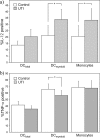Abnormal immunological profile and vaginal microbiota in women prone to urinary tract infections
- PMID: 19020112
- PMCID: PMC2620669
- DOI: 10.1128/CVI.00323-08
Abnormal immunological profile and vaginal microbiota in women prone to urinary tract infections
Abstract
The host determinants of susceptibility to recurrent urinary tract infections (UTI) are poorly understood. We investigated whether the susceptibility is associated with abnormalities in the immunological defense and further explored the linkage to vaginal microbiota. For this purpose, we compared vaginal, urine, and blood samples collected during a disease-free period from 22 women with recurrent UTI and from 17 controls. In UTI-prone women, interleukin-12 (IL-12) production in peripheral monocytes and myeloid dendritic cells (DCs) was significantly (P < 0.05) enhanced whether measured in relative numbers of IL-12-producing cells or in mean IL-12 production per cell. In contrast, no T-cell polarization was observed. Interestingly, it seemed that the cytokine production of DCs and monocytes did not translate into T-cell activation in the UTI-prone group in a manner similar to that seen with the controls. In vaginal mucosa, UTI-prone women had a lower concentration of tissue repair-associated vascular endothelial growth factor (VEGF) (P = 0.006) and less often had detectable amounts of the chief monocyte and DC chemoattractant, monocyte chemotactic protein 1 (P = 0.005), than the controls. The microbiota of UTI-prone women was characterized by a diminished lactobacillus morphotype composition, with an abnormally high (>3) mean Nugent score of 4.6 compared to 1.7 for the controls (P = 0.003). Normal lactobacillus composition was associated with increased IL-17 and VEGF concentrations in vaginal mucosa. In conclusion, immunological defects and a persistently aberrant microbiota, a lack of lactobacilli in particular, may contribute to susceptibility to recurrent UTI. Further studies of antigen-presenting-cell function and T-cell activation in recurrent UTI are called for.
Figures


Similar articles
-
Microbiota analysis of perimenopausal women experiencing recurrent vaginitis in conjunction with urinary tract infection.BMC Microbiol. 2025 Jan 4;25(1):1. doi: 10.1186/s12866-024-03709-3. BMC Microbiol. 2025. PMID: 39755613 Free PMC article.
-
Vaginal microbiota of spayed dogs with or without recurrent urinary tract infections.J Vet Intern Med. 2014 Mar-Apr;28(2):300-4. doi: 10.1111/jvim.12299. Epub 2014 Jan 27. J Vet Intern Med. 2014. PMID: 24467326 Free PMC article.
-
Inflammatory and antimicrobial properties differ between vaginal Lactobacillus isolates from South African women with non-optimal versus optimal microbiota.Sci Rep. 2020 Apr 10;10(1):6196. doi: 10.1038/s41598-020-62184-8. Sci Rep. 2020. PMID: 32277092 Free PMC article.
-
The Vaginal Microbiota and Urinary Tract Infection.Microbiol Spectr. 2016 Dec;4(6):10.1128/microbiolspec.UTI-0025-2016. doi: 10.1128/microbiolspec.UTI-0025-2016. Microbiol Spectr. 2016. PMID: 28087949 Free PMC article. Review.
-
The urobiome in men and women: a clinical review.Clin Microbiol Infect. 2023 Oct;29(10):1242-1248. doi: 10.1016/j.cmi.2022.08.010. Epub 2022 Aug 24. Clin Microbiol Infect. 2023. PMID: 36028087 Review.
Cited by
-
The Effects of Single Strains and Mixtures of Probiotic Bacteria on Immune Profile in Liver, Spleen, and Peripheral Blood.Front Nutr. 2022 Apr 12;9:773298. doi: 10.3389/fnut.2022.773298. eCollection 2022. Front Nutr. 2022. PMID: 35495948 Free PMC article.
-
New Insights into Photobiomodulation of the Vaginal Microbiome-A Critical Review.Int J Mol Sci. 2023 Aug 31;24(17):13507. doi: 10.3390/ijms241713507. Int J Mol Sci. 2023. PMID: 37686314 Free PMC article. Review.
-
Obstetric and gynecological diseases and complications resulting from vaginal dysbacteriosis.Microb Ecol. 2014 Aug;68(2):173-84. doi: 10.1007/s00248-014-0414-5. Epub 2014 Apr 8. Microb Ecol. 2014. PMID: 24711012 Review.
-
Characterization of host immunity during persistent vaginal colonization by Group B Streptococcus.Mucosal Immunol. 2015 Nov;8(6):1339-48. doi: 10.1038/mi.2015.23. Epub 2015 Apr 8. Mucosal Immunol. 2015. PMID: 25850655 Free PMC article.
-
Pyrosequencing analysis of the human microbiota of healthy Chinese undergraduates.BMC Genomics. 2013 Jun 10;14:390. doi: 10.1186/1471-2164-14-390. BMC Genomics. 2013. PMID: 23758874 Free PMC article.
References
-
- Almeida, J., C. Bueno, M. C. Alguero, M. L. Sanchez, M. C. Canizo, M. E. Fernandez, J. M. Vaquero, F. J. Laso, L. Escribano, J. F. San Miguel, and A. Orfao. 1999. Extensive characterization of the immunophenotype and pattern of cytokine production by distinct subpopulations of normal human peripheral blood MHC II+/lineage− cells. Clin. Exp. Immunol. 118392-401. - PMC - PubMed
-
- Aroutcheva, A., D. Gariti, M. Simon, S. Shott, J. Faro, J. A. Simoes, A. Gurguis, and S. Faro. 2001. Defense factors of vaginal lactobacilli. Am. J. Obstet. Gynecol. 185375-379. - PubMed
-
- Baecher-Allan, C., V. Viglietta, and D. A. Hafler. 2004. Human CD4+CD25+regulatory T cells. Semin. Immunol. 1689-98. - PubMed
Publication types
MeSH terms
Substances
LinkOut - more resources
Full Text Sources
Other Literature Sources
Medical
Research Materials

